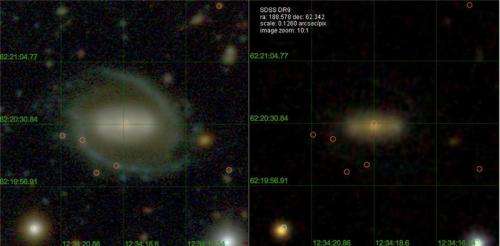Unprecedented sky survey maps galactic evolution

The ALHAMBRA project, led by researchers from the Instituto de Astrofísica de Andalucía and in which the University of Valencia has participated, has identified and classified more than half a million galaxies, after seven years of close observation of the universe from the Observatory of Calar Alto (CAHA, Almería) and thanks to a technique that breaks the stars energy in their colours through astronomical filters.
In addition, this research has also calculated the distances from these galaxies to us with unprecedented accuracy. ALHAMBRA (Advanced Large, Homogeneous Area Medium Band Redshift Astronomical survey) has a system of twenty filters covering all wavelengths in the optical and three filters in the infrared, which accurately determines the energy emitted by galaxies and the distance of half a million galaxies with unprecedented depth for the sample size.
The ALHAMBRA mapping represents an ambitious scientific project that has mobilised scientists from sixteen research institutes. Led by Mariano Moles (CEFCA) and developed in the Instituto de Astrofísica de Andalucía (IAA-CSIC), it was designed to trace the universe's evolution during the last ten million years. "ALHAMBRA represents a decisive step to solve pressing issues in cosmology and astrophysics through photometric mapping, offering accuracy required to determine the distance of the detected objects," Moles says. Thus, "the unbiased character of these mappings allows obtaining relevant data for all cosmic scales and, in this sense, the ALHAMBRA project is a precursor of the new long-range mapping that is being proposed."
Professor in Astronomy and Astrophysics at the Astronomic Observatory at the University of Valencia, Martínez explains that the range of cosmic distances achieved is "impressive and, therefore, it allows us to scan the cosmic evolution. In astronomy, looking away is looking at the past. We can get to know how galaxies were in early stages of the universe history."
"The research team have been able to coordinate themselves using the 3.5 metres telescope of Calar Alto to get spectacular results. Part of the data has already been made available to the community. Their analysis will still provide more surprising results in the next months," Martinez adds.
Until now, astronomers have explored either large areas and shallow distances or very deep samples of the sky, which do not take into account cosmic variance, resulting from the fact that the universe has regions of varying galactic densities.
"In this sense, the ALHAMBRA project has allowed us to confirm that the COSMOS sampling, one of the most referenced cosmological studies, is not representative of how galaxies are distributed in the universe because its area is limited in a space with overdensity of galaxies with regard to the average; the proximity makes the galaxies evolve faster, so that the evolutionary studies generated by COSMOS have a local character," Alberto Molino (IAA-CSIC) says.
A mapping applicable to all scales
ALHAMBRA studies how the stellar content of galaxies has changed over time, i.e, how, when and how much galaxies have aged. Furthermore, to establish a clear relationship between the morphology, the content of the stars, and the age of galaxies will allow us to finally understand which physical processes rule the universe at those scales.
ALHAMBRA will also reveal how the galaxies are distributed in the universe. "In the last thirteen billion years, gravity has been responsible for the formation of structures, such as galaxies or stars," Alberto Molino, researcher of the Instituto de Astrofísica de Andalucía says. "Studying how galaxies are arranged allows us to know the physical properties that controlled the universe at earlier times. It would be like knowing the place and conditions where the seeds were planted in a forest from the trees that we see today."
The ALHAMBRA observations have crossed enormous regions of our galaxy. To make a census of stars of the galactic halo, to discover variable stars, to know the frequency with which the stars pair off or to identify candidate stars to host other planets will allow exploring also the cosmic history of the Milky Way.
500,000 galaxies within reach
The imminent publication of the data offers free access to the potential of ALHAMBRA, not only for the international scientific community, but also for universities, scientific museums, astronomical associations or schools anywhere. The scientific value of this legacy also serves as fuel for future mapping generations such as JPAS, which will extend ALHAMBRA's work from a few regions of the sky to the whole observable universe.
More information: For more information, see www.alhambrasurvey.com
Provided by Asociacion RUVID



















